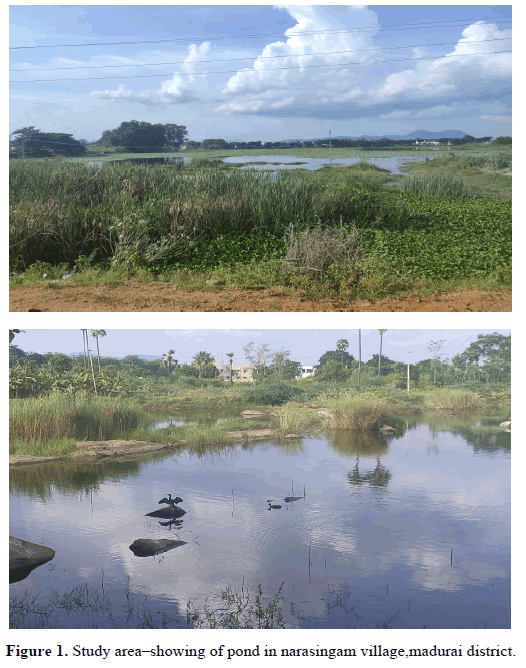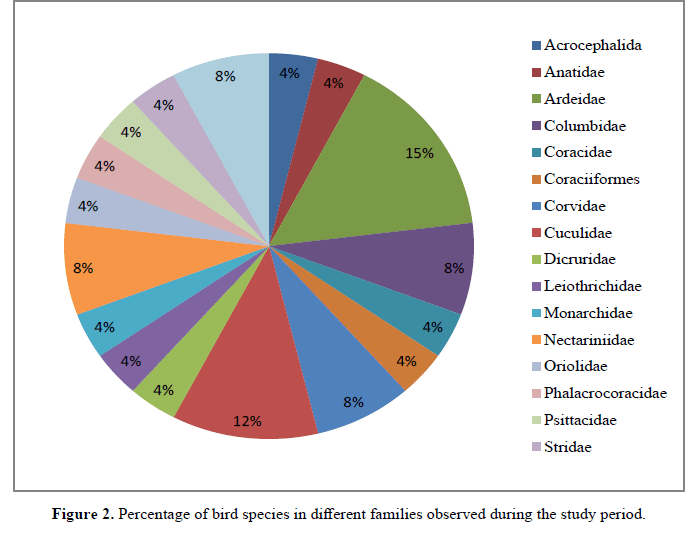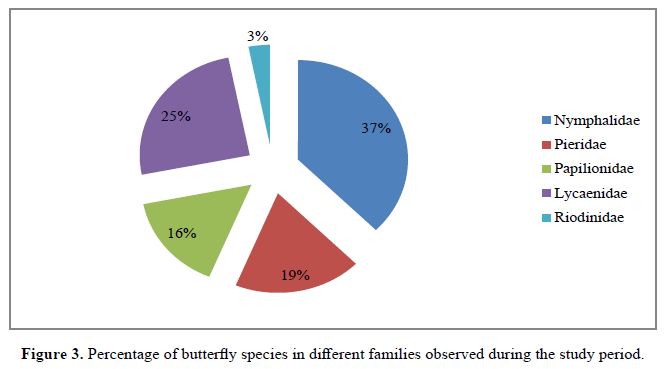Research Article - International Journal of Pure and Applied Zoology (2022) Volume 10, Issue 11
DIVERSITY OF BIRDS AND BUTTERFLIES IN AND AROUND FROM POND IN NARASINGAM VILLAGE, MADURAI DISTRICT, TAMIL NADU STATE, INDIA
Selvaraj Selvamurugan*
Department of Clinical Development Service Agency, Translational Health Science and Technology Institute Building (THSTI), Faridabad-121001, India
- Corresponding Author:
- Selvaraj Selvamurugan
Department of Clinical Development Service Agency
Translational Health Science and Technology Institute Building (THSTI)
Faridabad-121001, India
E-mail: selva199420@yahoo.in
Received: 10-Oct-2022, Manuscript No. IJPAZ-22-76809; Editor assigned: 12-Oct-2022, PreQC No. IJPAZ-22-76809(PQ); Reviewed: 26-Oct-2022, QC No. IJPAZ-22-76809; Revised: 31-Oct-2022, Manuscript No. IJPAZ-22-76809(R); Published: 07-Nov-2022, DOI: 10.35841/2320-9585-10.11.151
Abstract
Butterflies are important bio indicators which should be protected to conserve the biodiversity. The present investigation deals with observed in birds 26 species, 12 orders and 17 families recorded from during June 2021 to June 2022. Butterflies are 32 species and five families observed. In this paper showed the richness species of pond and conservation management.
Keywords
Birds, Butterflies, Fauna of Lake, Preliminary Study, Diversity.
Introduction
Bird community evaluation has become an important tool in biodiversity conservation and for identifying conservation actions in areas of high human pressure. All types of birds are incredibly fascinating and have captured our imagination since the earliest times. The Indian subcontinent is very rich in biodiversity. According to an estimate, 1300 bird species are found in Indian subcontinent, out of the more than 9000 bird species of the world and over 13% of the world’s bird fauna are found in India [1]. It is suggested that the avifauna is important for the good health of the ecosystem as these birds play various roles as scavengers, pollinators and predators of insect pests [2]. They are natural wonders of song, colour, flight and display. With so many diverse types of birds, learning about them is an exciting adventure. Birds contribute most significantly to the diversity of terrestrial habitats. Birds also have a special role in conservation as they not only help identify areas most worth saving, but also have the capacity to realize the significance of conservation [3].
Butterflies are the most beautiful, colourful and important group of insects in the world. These are very good pollinators as well as they play a role as predators, pests and weed killers Butterflies (as pollinators) contribute significantly to the growth, the maintenance, and an expansion of flora in tropical regions where these insects are abundant and diverse. Furthermore, butterflies are so sensitive to environmental changes and have been found as bio indicators, capable of indicating the environment's general health.
So far, 1501 species of butterflies have been recorded from the Indian region, with 350 species from Peninsular India, 331 species from the Western Ghats, and 313 species from South India [4]. The major forest areas in Tamil Nadu are divided into the Western and Eastern Ghats. When compared to the Western Ghats, the Eastern Ghats face intense pressure from all sides from people for fuel wood, fodder, medicinal plants, and illegal felling, causing it to lose forest cover at an unprecedented rate [5].
Many species are becoming increasingly rare, and some are on the verge of extinction, as a result of factors such as increased urbanisation, including roads and buildings, habitat destruction, fire, pesticide use, and an illegal trade. Butterflies, as one of the most studied insect groups, have been meticulously documented since the 18th century [6].
Deterioration of Pond water is also responsible for public health problems in surrounding area. Therefore, regular monitoring of pond water quality & pond ecosystem is necessary for taking appropriate environmental measures to protect & conserve pond water quality suitable for urban ecosystem.
Study site
Narasingam is a village located 8 km from Madurai on the road to Melur, in the Indian state of Tamil Nadu. It is named for the nearby cave temple dedicated to Yoga Narasimha Perumal, at the foot of the Yanaimalai hills. This temple was constructed in 770 A.D. by Madurakavi alias Marankaari who was the minister of the Madurai King Parantaka Nedunjadaiyan. Showing study area of Lotus pond and growing weeds in (Figure 1).
Results and Discussion
A total 26 species and 17 families recorded from during study period (Table 1). Following families viz., Ardeidae (4 species), Cuculidae (3 species), Columbidae (2 species), Threskiornithidae (2 species), Corvidae (2 species) Nectariniidae (2species) and followed by only one species namely are Coracidae, Coraciiformes, Dicruridae, Leiothrichidae, Monarchidae, Oriolidae, Phalacrocoracidae, Psittacidae, Stridae, Acrocephalida, Anatidae (Figure 2). Muralikrishnan, reported Urban ponds of Thirupparankundram and Koothiyarkundu, Madurai, During the study period, 49 species of birds belonging to 29 families under 42 genera were recorded [7].
| S.No | Scientific Name | Common Name | Order | Family |
|---|---|---|---|---|
| 1 | Terpsiphone paradise | Asian Paradise Flycatcher | Passeriformes | Monarchidae |
| 2 | Dicrurus macrocercus | Black Drongo | Passeriformes | Dicruridae |
| 3 | Columba livia | Blue Rock Pigeon | Columbiformes | Columbidae |
| 4 | Corvus splendens | Common Crow | Passeriformes | Corvidae |
| 5 | Hierococcyx varius | Common Hawk Cuckoo | Cuculiformes | Cuculidae |
| 6 | Eudynamys scolopacea | Common Koel | Cuculiformes | Cuculidae |
| 7 | Acridotheres tirstis | Common Myna | Passeriformes | Acrocephalida |
| 8 | Centropus sinensis | Greater Coucal | Cuculiformes | Cuculidae |
| 9 | Oriolus kundoo | Golden Oriole | Passeriformes | Oriolidae |
| 10 | Threskiornis aethiopicus | Ibis | Pelecaniformes | Threskiornithidae |
| 11 | Coracias benghalensis | Indian Roller | Coriciiformes | Coracidae |
| 12 | Nycticorax nycticorax | Night Heron | Pelecaniformes | Ardeidae |
| 13 | Ardeola grayii | Pond Heron | Pelecaniformes | Ardeidae |
| 14 | Leptocoma zeylonica | Purple rumped Sunbird | Passeriformes | Nectariniidae |
| 15 | Cinnyris asiaticus | Purple Sunbird | Passeriformes | Nectariniidae |
| 16 | Psittacula krameri | Rose ringed Parakeet | Psittaciformes | Psittacidae |
| 17 | Dendrocitta vagabunda | Rufous Tree pie | Passeriformes | Corvidae |
| 18 | Athene brama | Spotted Owl | Strigiformes | Stridae |
| 19 | Halcyon smyrnensis | White throated Kingfisher | Halcyon smyrnensis | Coraciiformes |
| 20 | Turdoides affinis | Yellow billed Babbler | Turdoides affinis | Leiothrichidae |
| 21 | Egretta garzetta | Little Egret | Pelecaniformes | Ardeidae |
| 22 | Bubulcus ibis | Cattle egret | Pelecaniformes | Ardeidae |
| 23 | Streptopelia chinensis | Spotted Dove | Columbiformes | Columbidae |
| 24 | Phalacrocorax niger | Little Cormorant | Suliformes | Phalacrocoracidae |
| 25 | Threskiornis melanocephalus | Oriental White Ibis | Pelecaniformes | Threskiornithidae |
| 26 | Anas poecilorhyncha | Spot-bill Duck | Anseriformes | Anatidae |
Table 1. Bird species observed in pond from June 2021 – June 2022.
This similar pattern of study was reported on wetland birds in Anekere wetland of Karkala, Udupi District; Pallikaranai Wetlands of Chennai; Kundavada Lake of Davanagere District; Chhilchhila Wildlife Sanctuary of Haryana and wetlands of Jalpaiguri, West Bengal [8-12]. These studies also recorded the seasonal change in density and diversity of migratory avifauna of which some are globally threatened and near threatened species.
The results of the present study revealed a total 32 species butterflies belonging to five families (Table 2). Family wise diversity of butterfly was dominated by Nymphalidae (12 species), Lycaenidae (8 species), Pieridae (6 species), Papilionidae (5 species), Riodinidae one species (Figure 3). Butterfly diversity in Tamil Nadu is studied in a variety of locations, primarily from the The Nilgiri Mountains are located in the Western Ghats. In the present study 22 species were recorded. Similar study was carried out by number of workers. Gunathilagaraj, reported 174 species of butterflies from Palani Hills and 85 butterfly species from Thengumarahada in the Nilgiris [13,14]. Reported about 27 species from Maruthamalai Hills of Southern Western Ghats [15]. There are about 71 species were recorded from Pachamalai hills of the Eastern Ghats of Tamil Nadu. Selvaraj Selvamurugan reported, 45 species of butterflies, 31 genera belonging to 5 families at foot hills of western ghats, Coimbatore, Tamil Nadu [16].
| S.No | Scientific Name | Common Name |
|---|---|---|
| Nymphalidae | ||
| 1 | Tirumala limniace | Blue tiger |
| 2 | Acraea violae | Tawny coster |
| 3 | Ariadne ariadne | Angled castor |
| 4 | Danaus chrysippus | Joker |
| 5 | Euploea core | Plain tiger |
| 6 | Junonia hierta | Yellow pansy |
| 7 | Junonia lemonias | Lemon pansy |
| 8 | Mycalesis sp. | Tamil bushbrown |
| 9 | Hypolimnas misippus | Danaid eggfly |
| 10 | Euploea core | Common crow |
| 11 | Neptis hylas | Common sailor |
| 12 | Junonia orithiya | Blue pansy |
| Pieridae | ||
| 13 | Colotis eucharis | Plain Orange Tip |
| 14 | Eurema brigitta | Small grass yellow |
| 15 | Leptosia nina | Psyche |
| 16 | Catopsilia pomona | Common emigrant |
| 17 | Appias albina | Common albatross |
| 18 | Belenois aurota | Pioneer |
| Papilionidae | ||
| 19 | Papilio demoleus | Common lime |
| 20 | Graphium doson | Common jay |
| 21 | Atrophaneura aristolochiae | Common rose |
| 22 | Atrophaneura hector | Crimson rose |
| 23 | Graphium Agamemnon | Tailed jay |
| Lycaenidae | ||
| 24 | Castalius rosimon | Common pierrot |
| 25 | Euchrysops cnejus | Gram blue |
| 26 | Zizeeria karsandra | Dark grass blue |
| 27 | Tarucus nara | Striped pierrot |
| 28 | Chilades lajus | Lime blue |
| 29 | Curetis thetis | Indian sunbeam |
| 30 | Prosotas nora | Common line blue |
| 31 | Spalgis epius | Ape fly |
| Riodinidae | ||
| 32 | Abisara bifasicata | Double banded judy |
Table 2. Diversity of butterfly species recorded in the study area.
Conclusion
The survival of Species is higher in urban cities which have rich vegetation and favorable habitat like the Narasingam pond. Considering the pond, with effective Implementation of the ecological conservation strategies, the species diversity, richness and community structure of the butterflies could be restored efficiently.
Environmental management aspects for restoration and conservation of pond:
Some of the important measures required are listed below:
1. The dumping of solid waste in the lake should be banned with the provision of punishment of such activity.
2. The macrophytes in lake should be regularly removed before summer season and may be property disposed off for composting purpose or for biogas preparation
3. Deepening the sha llow areas of lake would control the weed growth in lake.
4. Desludging operations during lean period of summer season would be helpful to remove the accumulated pollutants in the lake.
5. Regular physicochemical & biological monitoring of the lake water & lake ecosystem should be done.
References
- Grimmett, R., Inskipp, C., Inskipp, T., and Byers, C., 1999. Pocket guide to the birds of the Indian subcontinent. Oxford University Press.
- Padmavathy, A., Alexandar, R., and Anbarashan, M., 2010. Diversity of birds in ousteri wetland, Puducherry, India. Our. Nat., 8: 247-253.
- Daniels, R.J., 1994. A landscape approach to conservation of birds. J. Biosci., 19: 503-509.
- Kunte, K.., 1998. Butterflies of Peninsular India. Universities press, 254.
- Gaonkar, H., 1996. Butterflies of the Western Ghats, India including Sri Lanka: Biodiversity assessment of a threatened mountain system, Centre for Ecological Sciences, 18.
- Heppner J.B., 1998. Classification of Lepidoptera. Part I Introduction. Holarct. Lepid., 5:148.
- Muralikrishnan, S., Sonaimuthu, E.S.K., and Nagendran, N.A., 2019. Avifaunal assemblage in Urban ponds of Thirupparankundram and Koothiyarkundu, Madurai District, Tamilnadu, India. Eco. Env. Cons., 26: 550-555.
- Bhat, I.P., Cristopher, S.S., and Hosetti, B.B., 2009. Avifaunal diversity of Anekere wetland, Karkala, Udupi district, Karnataka, India. J. Environ. Biol., 30: 1059-1062.
- Nikhil R.P.P, Ranjini, J, Dhanya, R, Subramanian J, Azeez P.A, and Bhupathy, S., 2010. Consolidated checklist of birds in the Pallikaranai Wetlands, Chennai, India. J. Threat. Taxa; 2: 1114-1118.
- Harisha, M.N., Hosetti, B.B., and Shahnawaz, A., 2011. Wetland avifauna of Kundavada Lake, Davanagere dist., Karnataka. Curr. Biot., 5: 351-358.
- Kumar, P., and Gupta, S.K., 2013. Status of wetland birds of Chhilchhila Wildlife Sanctuary, Haryana, India. J. Threat. Taxa., 3969-3976.
- Datta, T., 2011. Human interference and avifaunal diversity of two wetlands of Jalpaiguri, West Bengal, India. J. Threat. Taxa., 2253-2262.
- Gunathilagaraj, K., Kumar, M.G., and Ramesh, P.T., 1997. Butterflies of Coimbatore. Zoos. Print. J., 12: 26-27.
- Rufus, K.C., and Sabarinathan, S.P., 2007. A checklist of butterflies of Thengumarahada in the Nilgiris, southern India. Zoos. Print. J., 22: 2837-2838.
- Jothimani, K., Ramachandran, V.S., and Rajendran, A., 2014. Role of butterflies as pollinators in Maruthamalai Hills of Southern Western Ghats. Acad. J. Entomol,, 7: 7-16.
- Selvaraj, S., 2018. A report on butterfly diversity foot hills of western Ghats, Coimbatore District, Tamilnadu. Int. J. Rec. Res. Life. Sci., 8: 3209-3213.
Indexed at, Google Scholar, Cross Ref
Indexed at, Google Scholar, Cross Ref
Indexed at, Google Scholar, Cross Ref


